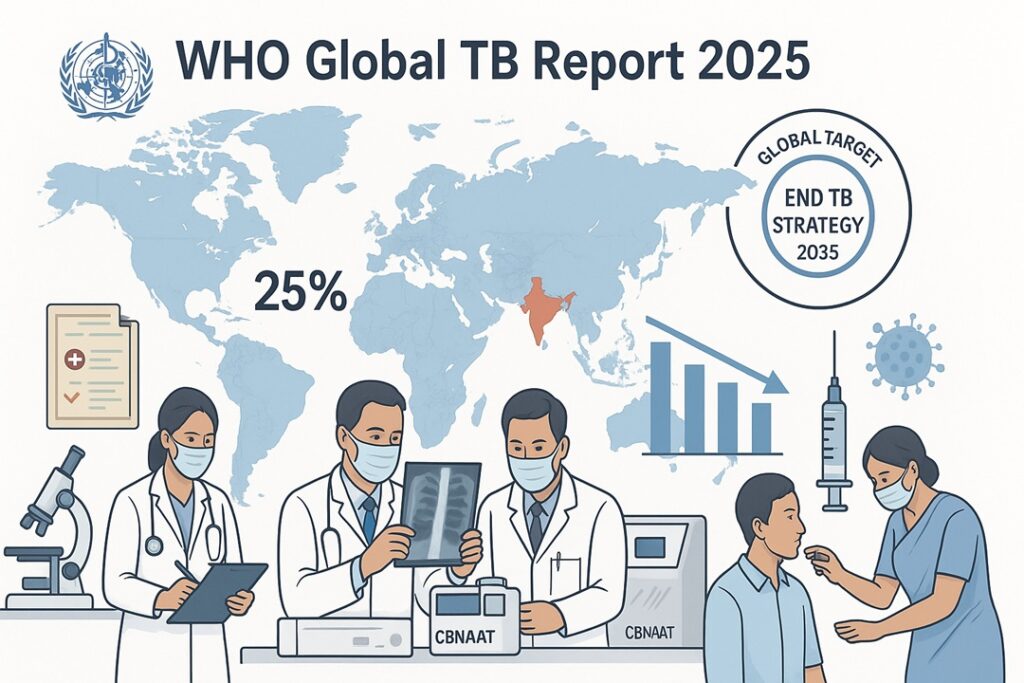WHO Global TB Report 2025: Evaluating India’s Efforts Toward TB Elimination

Context:
The WHO Global Tuberculosis Report 2025 reveals that India continues to account for the highest TB burden globally (25% of total cases), despite achieving a 21% reduction in incidence since 2015.
About the Global TB Report 2025
Nature of the Report:
- An annual global assessment tracking trends in tuberculosis prevention, diagnosis, treatment, and outcomes.
- Provides data at global, regional, and national levels.
Published by:
- World Health Organization (WHO).
Objective:
- To monitor progress toward the End TB Strategy (2015–2035), which aims for:
- 90% reduction in TB deaths and
- 80% reduction in incidence by 2030.
- Supports countries in designing evidence-based TB control policies.
Global Trends in Tuberculosis
1. Global Incidence:
- TB incidence declined by 1.7% (2023–2024) to reach 131 cases per 100,000 population, recovering from pandemic-related setbacks.
2. Regional Distribution:
- Declines observed in Africa, South-East Asia, Eastern Mediterranean, and Europe,
while the Americas recorded a fourth consecutive increase due to under-detection.
3. Geographical Burden:
- South-East Asia (34%), Western Pacific (27%), and Africa (25%) account for most global TB cases.
4. High-Burden Countries:
- Eight nations contribute 67% of total cases — led by India (25%), Indonesia (10%), and the Philippines (6.8%).
5. Drug Resistance:
- Multidrug-resistant (MDR) TB remains a serious threat, with only limited progress in detection and treatment.
6. Funding Challenges:
- Global TB financing has stagnated since 2020, with projected donor cuts from 2025 posing risks to national programs.
TB Situation in India
1. Incidence Rate:
- TB incidence reduced from 195 (2023) to 187 (2024) per 100,000 population — a 21% decline since 2015, surpassing the global average decline of 12%.
2. Case Detection:
- India diagnosed 2.61 million of an estimated 2.7 million cases in 2024, significantly narrowing the “missing cases” gap.
3. Mortality Trends:
- TB deaths dropped from 28 (2015) to 21 (2024) per 100,000, though still higher than the 2025 target of 3 per 100,000.
4. Drug-Resistant TB:
- India accounts for 32% of global MDR-TB cases, though rates are gradually decreasing.
5. Policy Initiatives:
- Ni-kshay 2.0 and TB-Mukt Bharat Abhiyan enhanced treatment coverage (92%) and expanded molecular diagnostics nationwide.
Key Initiatives to Combat TB
Global Level:
- End TB Strategy (2015–2035): Aims for 90% mortality reduction and 80% incidence reduction by 2030.
- UN High-Level Meetings (2018, 2023): Reaffirmed commitments for funding, vaccine development, and universal care.
- Global Fund & Stop TB Partnership: Focus on financing, innovation, and surveillance.
- New WHO Guidelines (2024–25): Updated norms for MDR-TB treatment, TB–diabetes management, and diagnostics.
India Level:
- National Strategic Plan for TB Elimination (2017–2025): Seeks to eliminate TB by 2025, five years ahead of global targets.
- Ni-kshay Poshan Yojana: Provides nutritional support to TB patients.
- Pradhan Mantri TB Mukt Bharat Abhiyan: Encourages community and corporate participation in patient care.
- Expanded Diagnostics: Deployment of Truenat and CBNAAT molecular tests across districts.
Major Challenges
1. Undernutrition:
- Malnutrition among low-income groups weakens immunity and heightens TB susceptibility.
2. Rising MDR-TB Cases:
- Limited access to newer, shorter, and less toxic drug regimens hampers control efforts.
3. Funding Stagnation:
- Declining international support threatens continuity in treatment and diagnostics.
4. Weak Surveillance Systems:
- Poor data reporting, especially from rural and private sectors, delays detection and intervention.
5. Limited Vaccine Progress:
- Despite research, no new TB vaccine has reached large-scale use, slowing prevention efforts.
Recommendations
1. Accelerate Vaccine Research:
- Invest in next-generation TB vaccine development and equitable access mechanisms.
2. Expand Molecular Testing:
- Strengthen diagnostic coverage through Truenat, CBNAAT, and LAMP-based tests.
3. Secure Sustainable Financing:
- Increase domestic health allocations and explore blended finance models to reduce donor dependence.
4. Improve Nutrition & Social Support:
- Integrate TB programs with food security and welfare schemes to reduce vulnerability.
5. Leverage Digital Surveillance:
- Utilize AI-enabled monitoring systems for case tracking, adherence, and outcome evaluation.
Conclusion
The WHO Global TB Report 2025 underscores that tuberculosis remains the deadliest infectious disease worldwide.
While India has made notable progress in reducing incidence and deaths, it still faces hurdles in reaching elimination goals by 2025.
A comprehensive approach combining innovation in vaccines, sustainable financing, nutrition security, and digital health systems is essential to achieve a TB-free world.
Source : WHO
